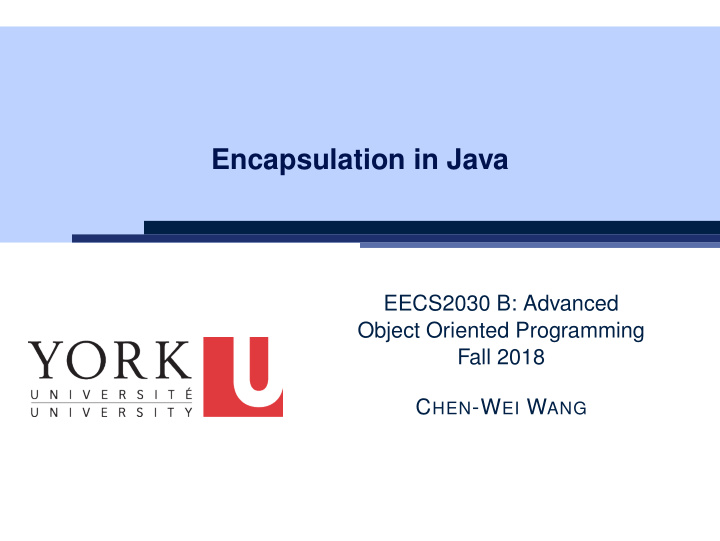



Encapsulation in Java EECS2030 B: Advanced Object Oriented Programming Fall 2018 C HEN -W EI W ANG
Encapsulation (1.1) Consider the following problem: ● A person has a name, a weight , and a height . ● A person’s weight may be in kilograms or pounds . ● A person’s height may be in meters or inches . ● A person’s BMI is calculated using their height in meters and weight in kilograms . Consider a first solution: class Person { public String name ; public double weight ; /* in kilograms */ public double height ; /* in meters */ public double getBMI () { return weight / ( height * height ); } } ● Since both attributes height and weight are declared as public , we do not need the setter methods for them. 2 of 9
Encapsulation (1.2) Say an application of the Person class mistakenly thinks that the height in inches and weight in pounds should be set: 1 class BMICalculator { 2 public static void main ( String args []) { 3 Person jim = new Person (); 4 /* Jim’s height and weight are 1.78 m and 85 kg */ 5 jim . weight = 85 * 2.2; 6 jim . height = 1.78 * 39; 7 System . out . println ( jim . getBMI ()); 8 } } 85 × 2 . 2 85 ● Line 7 : ( 1 . 78 × 39 ) 2 = 0 . 038, rather than 1 . 78 2 = 26 . 827!!! ● Solution: ○ Disallow any application class of Person to directly assign to weight and height . ○ Provide proper setter methods as the only means for assigning these two attributes. 3 of 9
Encapsulation (2.1) Now consider a better solution: class Person { public String name ; private double weight ; /* in kilograms */ private double height ; /* in meters */ public void setWeightInKilograms ( double k ) { weight = k ; } public void setWeightInPounds ( double p ) { weight = p / 2.2; } public void setHeightInMeters ( double m ) { height = m ; } public void setHeightInInches ( double i ) { height = i / 39; } public double getBMI () { return weight / ( height * height ); } } Exercise: Modify the Person class so that weight is measured in pounds and hegiht is measured in inches. 4 of 9
Encapsulation (2.2) Now an application of the Person class may only set the weight and height of a person by calling the appropriate methods: 1 class BMICalculator { 2 public static void main ( String args []) { 3 Person jim = new Person (); 4 /* Jim’s height and weight are 1.78 m and 85 kg */ 5 jim . setWeightInPounds (85 * 2.2); 6 jim . setHeightInInches (1.78 * 39); 7 System . out . println ( jim . getBMI ()); 8 } } ● Since both attributes weight and height in class Person are declared as private , it is disallowed in any other class (e.g., BMICalculator ) to access them (e.g., jim.weight ). ● Line 7 now should return the correct BMI value. 5 of 9
Encapsulation (3.1) ● Question : What if in the Person class, we want the weight attribute to mean pounds and height to mean inches? ● Hint : Which classes will you have to change? Person ? BMICalculator ? Both? ● Modify the setter methods in Person accordingly. [Exercise!] ● No change is needed in the BMICalculator ! ○ Since class BMICalculator was disallowed to access weight and height , as soon as the setter definitions are modified in Person , the calculation will still work! ● What we have achieved: ○ Implementation details in Person (i.e., weight and height ) are hidden from all potential applications (e.g., BMICalculator ). ○ When these implementation details are changed in Person (e.g., weight interpreted in pounds rather than in kilograms): ● Only the Person class has to be changed . ● All existing application classes can remain unchanged . 6 of 9
Encapsulation (3.2) ● A software component hides the internal details of its implementation, so that: ○ It has a stable interface; ○ Programmers of other components can only depend on its public interface , rather than writing code that depends on those implementation decisions ; ○ The component developer may change the implementation without affecting the code of any other components. ● In Java, we achieve this by ○ declaring attributes or helper methods as private ; ○ providing public accessors or mutators. 7 of 9
Encapsulation (3.3) ● Follow this tutorial video: https: //www.youtube.com/watch?v=d2Q-uasRmAU&index=1& list=PL5dxAmCmjv_492h1b0yiZSyhC3ImEetLV ● For complete details about controlling the access for attributes, refer to: https://docs.oracle.com/javase/tutorial/java/ javaOO/accesscontrol.html 8 of 9
Index (1) Encapsulation (1.1) Encapsulation (1.2) Encapsulation (2.1) Encapsulation (2.2) Encapsulation (3.1) Encapsulation (3.2) Encapsulation (3.3) 9 of 9
Recommend
More recommend